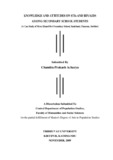Please use this identifier to cite or link to this item:
https://elibrary.tucl.edu.np/handle/123456789/3529| Title: | Knowledge and Attitudes on Stisand Hiv/Aidsamong Secondary School Students (A Case Study of Shree Khand Devi Secondary School, Satakhani, Chaurase, Surkhet) |
| Authors: | Acharya, Chandra Prakash |
| Keywords: | Transmission of HIV/AIDS;Caste;Household |
| Issue Date: | 2009 |
| Publisher: | Department of Population Studies |
| Institute Name: | Central Department of Population Studies |
| Level: | Masters |
| Abstract: | Sexually transmitted infections (STIs) and HIV/AIDS are the majorchallenges for world health to emerge in 21 iv st century. The aids epidemic maybe the most devastating health disaster in human history. HIV/AIDS hasbecome major as well as critical public health issue particularly in Africafacing the worst effect of the epidemic. At least 45 million people are nowliving with HIV in the world. An estimated 5.1 million people were newlyinfected with HIV by the end of 2008. Among them 95 percent in Sub-SaharanAfrica, easternEurope and Asia. The study on “knowledge and Attitudes on STIs and HIV/AIDS amongsecondary school students in Shree Khand Devi secondary school’s students inSatakhani, Chaurase, Surkhet” has been carried out by using primary datacollected from one secondary school of Satakhani VDC. The main objectivesof the study are to evaluate the knowledge and perception about the modes oftransmission and method of prevention of STIs and HIV/AIDS. The samplesize is 150 students of the selected school and they areselected by purposivesampling method. Out of the total sample size of 150 students, 78 are boys and72 are girls. They are from both class nine and ten. The average age of respondents is 15 years and their average family sizeis 5 to 10 member. About 16percent respondent’s father’s have educationallevel of S.L.C and above, whereas the major occupation of the respondent’sparent’s (79.5% father and 93.2% mother) are engaged in agriculturaloccupation. The majority of the respondents (38.7%) are Brahmin,Magar andChhetri constitute second and third rand respectively. Majority of therespondents (93.3%) are unmarried. Almost respondents (89.3%) have heardabout STIs. Large proportion of the respondents (97%) stated that sexualcontact with infected person is the most important mode of transmission ofSTIs and all of the respondents reported that use of condom during sexualintercourse is the most important way of prevention from STIs. All of the respondents reported that they have heard about HIV/AIDSbecause of the electronic media and their curriculum also includes about HIV/AIDS. All of the respondents know the ways of transmission of HIV/AIDS issexual contacts. All of the respondents reported that the use of condom is themost important and effectivemethod of prevention of HIV/AIDS. Most of therespondents (96.7%) reported that the commercial sexworkers are vulnerable toHIV/AIDS in the society. Majority of the respondents have accepted AIDSinfected persons all of them die which is accounted for (69.3%). |
| URI: | http://elibrary.tucl.edu.np/handle/123456789/3529 |
| Appears in Collections: | Population Studies |
Files in This Item:
| File | Description | Size | Format | |
|---|---|---|---|---|
| thesis.pdf | 435.58 kB | Adobe PDF |  View/Open |
Items in DSpace are protected by copyright, with all rights reserved, unless otherwise indicated.
